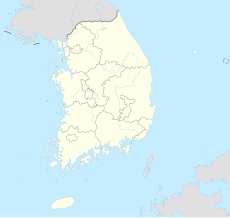Gunsan Airport
Gunsan Airport 군산공항 | |||||||||||
|---|---|---|---|---|---|---|---|---|---|---|---|
| Summary | |||||||||||
| Airport type | Public / Military | ||||||||||
| Owner | Ministry of Land, Infrastructure and Transport | ||||||||||
| Operator | |||||||||||
| Serves | Gunsan | ||||||||||
| Location | Gunsan, North Jeolla Province, South Korea | ||||||||||
| Opened | August 1970 | ||||||||||
| Elevation AMSL | 29 ft / 9 m | ||||||||||
| Coordinates | 35°55′33.46″N 126°36′56.4″E / 35.9259611°N 126.615667°E | ||||||||||
| Website | www | ||||||||||
| Map | |||||||||||
 | |||||||||||
| Runways | |||||||||||
| |||||||||||
| Statistics (2019) | |||||||||||
| |||||||||||
| Gunsan Airport | |
| Hangul | 군산공항 |
|---|---|
| Hanja | 群山空港 |
| Revised Romanization | Gunsan Gonghang |
| McCune–Reischauer | Kunsan Konghang |
Gunsan Airport (IATA: KUV, ICAO: RKJK) is an airport serving Gunsan, a city in the North Jeolla Province in South Korea. In 2019, 306,518 passengers used the airport.[2] It shares its runway with Kunsan Air Base, which uses the same IATA and ICAO codes. Because Gunsan Airport is sharing with military, taking photograph or video of apron, runway and military facility is strictly prohibited.
History
[edit]The routes between Seoul and Gunsan were opened in August 1970, but the airport was closed in 1974 due to the first oil shock, but the construction of the civil harbor facility started in November 1991 and reopened on December 14, 1992. On December 14, 1992, Korean Air (Korean Air) opened a new route to Seoul, Gunsan, Gunsan, and Jeju Island and was operated by Asiana Airlines in June 1996, but Asiana Airlines was suspended from service in October 2001. Since November 1992, it has been managed by the Gunsan Branch of the Korea Airport Corporation. As of 2004, the Gunsan - Jeju route will be operated.[3]
Facilities
[edit]The airport is at an elevation of 29 feet (8.8 m) above mean sea level. It has one runway designated 18/36 with a concrete surface measuring 9,000 by 150 feet (2,743.2 m × 45.7 m).[1]
Airlines and destinations
[edit]| Airlines | Destinations |
|---|---|
| Eastar Jet | Jeju[4] |
| Jin Air | Jeju[5] |
Statistics
[edit]Graphs are unavailable due to technical issues. There is more info on Phabricator and on MediaWiki.org. |
| Air traffic statistics | |||
|---|---|---|---|
| Aircraft operations | Passenger volume | Cargo tonnage | |
| 2001 | 3,151 | 244,573 | 2,588 |
| 2002 | 1,728 | 152,254 | 2,259 |
| 2003 | 1,388 | 150,635 | 2,138 |
| 2004 | 1,366 | 132,446 | 1,724 |
| 2005 | 1,366 | 163,779 | 1,648 |
| 2006 | 1,194 | 155,207 | 1,944 |
| 2007 | 1,109 | 133,242 | 1,571 |
| 2008 | 782 | 99,669 | 1,456 |
| 2009 | 1,324 | 156,402 | 1,543 |
| 2010 | 1,387 | 174,638 | 1,610 |
| 2011 | 1,398 | 172,327 | 1,633 |
| 2012 | 1,350 | 161,009 | 1,485 |
| 2013 | 1,444 | 175,492 | 1,451 |
| 2014 | 1,205 | 154,189 | 1,046 |
| 2015 | 1,432 | 205,438 | 1,301 |
| 2016 | 1,427 | 232,132 | 1,320 |
| 2017 | 1,420 | 225,797 | 1,267 |
| 2018 | 1,798 | 291,941 | 1,636 |
| 2019 | 1,955 | 306,518 | 1,674 |
| 2020 | 1,012 | 109,800 | 551 |
| 2021 | 2,404 | 280,197 | 1,430 |
| 2022 | 2,681 | 409,738 | 2,101 |
| 2023 | 1,124 | 172,939 | 880 |
| Source: Korea Airports Corporation Traffic Statistics[6] | |||
See also
[edit]References
[edit]- ^ a b "Incheon International Airport".
- ^ a b Air Traffic by Airport Archived 2007-09-29 at the Wayback Machine
- ^ "군산공항". Doopedia (in Korean). Retrieved 2018-04-29.
- ^ "이스타항공, 내달 군산∼제주 노선 신규 취항" [Eastar Jet, launches Gunsan~Jeju route in next month] (in Korean). Yonhap News Agency. 6 September 2023.
- ^ "진에어·제주항공, 제주 노선 신규 취항…매일 2회 운항" (in Korean). Yonhap News Agency. 29 September 2020.
- ^ "Air Traffic Statistics". Incheon International Airport. Archived from the original on 2020-01-14. Retrieved 23 July 2023.

